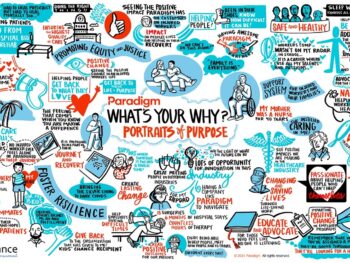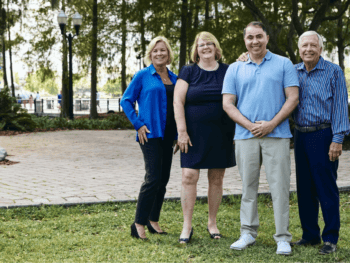
But what are the best practices to handle barriers to recovery and achieve optimal outcomes for injured workers — especially those who are severely injured? How can claims professionals proactively identify psychosocial obstacles and intervene appropriately to prevent unnecessary disability — along with significantly higher costs?
A multilayered strategy that takes a whole-person approach — including the injured worker’s family — has shown promising results, including lower medical spend, higher release to return-to-work rates, and less time to achieve targeted outcomes.
The important role of behavioral health
An injured worker is much more than just their injury. For years, the workers’ compensation system has been exclusively focused on the medical aspects of the workplace injury. Yet, other issues that can influence outcomes include:
- Mental health issues, such as depression, anxiety, and PTSD.
- Financial hardships, especially if the injured worker was the primary breadwinner.
- Family dynamics, including changes in roles and relationships and caregiver stresses/strains.
- Maladaptive coping behaviors, such as substance abuse or overeating.
- Premorbid conditions, like chronic pain, psychiatric illness, obesity, and diabetes.
Additionally, social determinants of health may affect recovery if, for example, the injured worker has substandard living arrangements, poor access to healthy food, or lack of transportation.
While none of these are direct effects of the workplace injury, any one of them can have a significant bearing on the person’s recovery and the outcome of a claim. Recent research shows the stark realities of the association between behavioral health factors and outcomes:
- A 2019 report from the American Hospital Association revealed:
- 75% higher medical costs among patients diagnosed with both behavioral health and other chronic conditions, compared to those without a co-occurring behavioral health diagnosis.
- 2–3 times higher costs for Medicaid beneficiaries with co-occurring behavioral health and chronic conditions.
- A 2020 Milliman study of more than 20 million people found medical costs were 2.8 to 6.2 times higher for patients with behavioral health issues than those without them. That study also showed that 10% of the population of the study contributed 70% of health care costs, and within that 10%, 6% had co-occurring behavioral conditions and accounted for nearly 44% of total health care costs.
“So clearly, we have an issue here and there’s no denying the fact that behavioral health issues and challenges relate quite strongly to health care costs and outcomes,” explained Deborah M. Benson, Ph.D., VP of Clinical Solutions of Paradigm. After the company conducted an internal study of its own data, Benson noted that, “We found a pretty clear relationship between the number of psychosocial problems over the course of recovery and a number of key metrics: higher medical costs, higher rates of one-year post-injury hospital readmissions, and lower rates of return to work.”
The post-acute phase of recovery is where behavioral health impacts often emerge. There may be a number of reactions that extend well beyond the immediate effects of the injury and are more related to the person’s adjusting or reacting to trauma-induced stress and the persistent/chronic effects of the injury. This can be a critical time for injured workers. Often they and their families do not know what to expect, what resources are available, and what their ongoing treatment is going to involve.
“All of these can lead to an avoidance of care and/or suboptimal compliance,” Benson said. “Those combinations often lead to poor outcomes.”
A multilayered solution
Doing a deep dive into its own experience, Paradigm developed predictive models to determine which injured workers are at the highest risk of behavioral health issues. To help them, community support specialists and behavioral health clinical specialists are brought in to the management team. These experts offer a unique level of support, depending on the needs of the injured worker and their family.
Community support specialists work with the injured worker through the entire recovery to provide:
- Early and direct emotional support.
- Education and coping tools.
- Mental health referrals, if indicated.
- Referrals to financial assistance and health insurance programs.
- Resources for social determinants of health, including food scarcity and transportation.
“Optimal health and healing is not just focusing on someone’s physical recovery, but will really include a focus on emotional health, socioeconomic factors, physical environment, and the entire family system,” said Tiffany Morvari, Community Support Specialist at Paradigm. “By focusing on all of those areas of an individual’s health and well-being, they are going to have the best chance of a solid and successful recovery and they are going to have the best outcomes.”
Having behavioral health experts involved in management teams has shown positive results. The company has found that cases with those professionals involved had lower-than-projected medical costs, higher return-to-work rates, faster achievement of outcomes and lower utilization of professional mental health services over the course of their recoveries, compared to those who did not have the benefit of these specialists.
Achieving long-term success
The goal of those involved in the multilayered approach to injured workers with behavioral health issues is to help them adapt and adjust to their post-injury life. For many, especially those most severely injured, that may require many changes.
“Perhaps not the same level of ability, the same level of function or lifestyle they were accustomed to pre-injury, but a new normal,” Benson said, “and an ability to cope with and move on in life with a new set of abilities and adjust in that respect.”
An important part of the adjustment process involves helping the injured worker figure out what they want for themselves, given their “new normal.” A key question they must answer is, what is the meaning?
“For a number of injured workers, their expectations fail, and they have no meaning,” said Tim Feeney, Ph.D., Behavioral Health Clinical Specialist at Paradigm. “They need a reason to get out of bed.”
Working with behavioral health clinical specialists, injured workers and their families begin to visualize what the future can hold. They develop goals and identify how they can become achievable. This involves looking at what is realistically possible as well as addressing issues of motivation. A key is focusing on goals that are important to the injured worker and their family, not just the other stakeholders involved. “There are a significant number of issues confronting people in the context of their lives, and while we may have great ideas about the best clinical approaches, sometimes there is a mismatch between what is doable and what we think is ideal,” Feeney said.
Behavioral health specialists can help injured workers restore a sense of self and create meaning in their new lives. The injured worker may associate themselves solely as a disabled person, or someone who is “less than.” Instead, they are taught to focus on who they want to be and then are given the support needed to become that person.
“The goal is to help them move forward and eventually self-manage without our support; being able to think, problem solve, be flexible,” Feeney noted. “So moving from patient-centered to patient-driven. Putting them in the driver’s seat.”
Conclusion
The advances made to help injured workers recover better and faster from their injuries can help them live longer and function in ways that were not previously possible. Taking a whole-person approach can minimize the impact of behavioral health issues on achieving optimal outcomes. And having the right health care professionals involved along the way can make all the difference in the world.
 Author Michael Stack, CEO Amaxx LLC. He is an expert in workers’ compensation cost containment systems and helps employers reduce their workers’ comp costs by 20% to 50%. He works as a consultant to large and mid-market clients, is a co-author of Your Ultimate Guide To Mastering Workers Comp Costs, a comprehensive step-by-step manual of cost containment strategies based on hands-on field experience, and is the founder & lead trainer of Amaxx Workers’ Comp Training Center, which offers the Certified Master of Workers’ Compensation national designation.
Author Michael Stack, CEO Amaxx LLC. He is an expert in workers’ compensation cost containment systems and helps employers reduce their workers’ comp costs by 20% to 50%. He works as a consultant to large and mid-market clients, is a co-author of Your Ultimate Guide To Mastering Workers Comp Costs, a comprehensive step-by-step manual of cost containment strategies based on hands-on field experience, and is the founder & lead trainer of Amaxx Workers’ Comp Training Center, which offers the Certified Master of Workers’ Compensation national designation.
Contact: mstack@reduceyourworkerscomp.com.
Workers’ Comp Roundup Blog: http://blog.reduceyourworkerscomp.com/
©2022 Amaxx LLC. All rights reserved under International Copyright Law.
Do not use this information without independent verification. All state laws vary. You should consult with your insurance broker, attorney, or qualified professional.
















